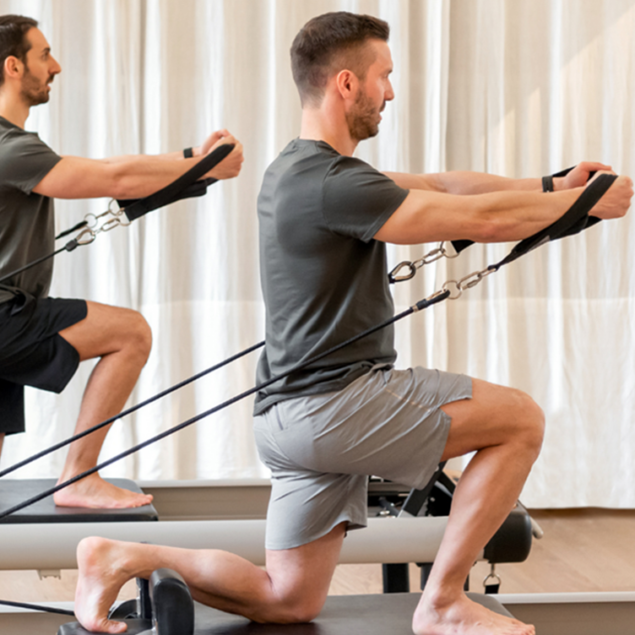Five common knee injuries — understanding the problem
Before diving into the benefits of Pilates, it’s important to understand the variety of knee injuries that can occur. The knee is a complex joint, and its injuries range from acute trauma to chronic conditions. Here are some of the most common knee injuries:
- Anterior Cruciate Ligament (ACL) injuries
The ACL is a major ligament that stabilises the knee. ACL injuries typically occur during contact sports that involve sudden stops, jumps or changes in direction. ACL injuries can be partial or complete tears, leading to instability and requiring rehabilitation or even surgery.
- Meniscus tears
Your meniscus is the cartilage that cushions your knee joint. Tears can happen due to sudden twisting movements or wear and tear over time. Meniscus injuries can lead to pain, swelling and reduced range of motion.
- Patellofemoral Pain Syndrome (PFPS)
Often referred to as “runner’s knee,” PFPS is characterised by pain around or behind the kneecap. It’s common among athletes and active individuals and is often related to muscle strength or overuse imbalances.
- Iliotibial Band Syndrome (ITBS)
ITBS is a condition that involves inflammation of the iliotibial band, a thick band of tissue that runs along the outside of the thigh. ITBS is frequently seen in runners and cyclists and can cause lateral knee pain.
- Tendonitis
Tendonitis around the knee, including patellar tendonitis, is often the result of repetitive strain or overuse. This condition is characterised by inflammation and pain, especially during movement.
Understanding the type of knee injury you have provides a backdrop for exploring why low-impact, controlled movements such as those offered by Pilates can benefit knee rehabilitation and overall joint health.
Why Pilates can assist in recovering from a knee injury — five major benefits of regular practice
Pilates offers many benefits that can address both the symptoms and the underlying causes of knee pain. Here are some of the key benefits you may experience through regular practice:
- A low-impact exercise that aids with recovery
Pilates is renowned for its low-impact approach. Unlike high-impact activities that can exacerbate knee pain, Pilates exercises are gentle on the joints. This makes it an excellent option for those recovering from injuries or managing chronic knee pain.
- Improved strength and stability
One of the major benefits of Pilates for knee injuries is the enhancement of muscle strength, particularly in the quadriceps, hamstrings and gluteal muscles. Strengthening these muscle groups can help stabilise the knee joint, reduce strain and improve overall function.
- Enhanced flexibility and range of motion
Restricted movement and stiffness are common after knee injuries. Pilates focuses on stretching and controlled movements that can help increase flexibility and restore the natural range of motion in the knee. This is crucial for reducing pain and preventing future injuries.
- Core strength and alignment
Pilates isn’t just about the legs. The exercises also emphasise core stability and proper alignment, which play a critical role in overall posture and biomechanics. A strong core can reduce compensatory movements that might otherwise place additional stress on the knees.
- Mind-body connection
Pilates encourages a focused approach to exercise. By focusing on your breathing and controlled movements, you become more aware of your body’s mechanics. This increased awareness can help you identify and correct movement patterns that may contribute to knee pain.
Effective Pilates reformer exercises for knee injuries
For those looking for structured, supportive environments, Pilates reformer exercises for knee injuries can provide an added level of guidance and resistance adjustment when incorporated with the following movements:
- Leg circles
Leg circles help improve hip mobility while strengthening the muscles around the knee. Start by lying on your back with one leg extended and the other raised. Gently rotate the raised leg in small circles, gradually increasing the range as your knee warms up.
- Single-leg stretch
The single-leg stretch targets the muscles of the lower body, particularly the quadriceps and hamstrings, which support knee stability. Lying on your back, draw one knee towards your chest while extending the other leg before alternating legs in a controlled motion.
- Bridging exercises
Bridging works your glutes and hamstrings, engages the core and helps stabilise the knee joint. Begin by lying on your back with your knees bent and feet flat on the floor or the reformer’s footbar. Slowly lift your hips towards the ceiling, squeezing your glutes at the top. Lower your hips back down with control.
- Wall squats
When performed correctly, squats are a staple in knee rehabilitation. Wall squats reduce the load on your knees while engaging the muscles necessary for knee support. Stand with your back against a wall and slide down into a squat position, keeping your knees aligned with your toes. Hold the position for a few seconds before slowly rising.
- Clamshells
Clamshells are excellent for strengthening the muscles around the hip and knee, contributing to better overall stability. Lying on your side with your knees bent, slowly raise your top knee and keep your ankles glued together. This movement targets the gluteus medius, which is crucial for proper knee alignment and can help alleviate lateral knee pain.
Start your journey to recovery with KX Pilates
At KX Pilates, we understand the physical, mental and emotional challenges of knee injuries and are committed to providing an inclusive, positive environment where you can safely rebuild your strength and confidence. Our experienced trainers tailor each session to meet your individual needs, ensuring that you perform each movement with the correct form and at the right pace for your recovery.
Book our introductory package of 5 classes for just $60 today and experience firsthand how Pilates can transform your rehabilitation journey.
